Study on the Temporal Variability and Influencing Factors of Baseflow in High-Latitude Cold Region Rivers: A Case Study of the Upper Emuer River
Abstract
1. Introduction
2. Materials and Methods
2.1. Study Area
2.2. Data Source
2.3. Methods
2.3.1. Digital Filtering Method
2.3.2. Smoothing Minima Method
2.3.3. Mann-Kendall Non-Parametric Test
2.3.4. Pearson Correlation Coefficient
3. Results and Analysis
3.1. Temporal Variations in Baseflow
3.1.1. Analysis of Annual Scale Evolution Patterns
3.1.2. Analysis of Seasonal Scale Evolution Patterns
3.1.3. Analysis of Monthly Scale Evolution Patterns
3.2. Temporal Variations in the Baseflow Index (BFI)
3.2.1. Analysis of Annual Scale Evolution Patterns
3.2.2. Analysis of Seasonal Scale Evolution Patterns
3.2.3. Analysis of Monthly Scale Evolution Patterns
3.3. Analysis of Influencing Factors of Baseflow in the Snowmelt Period
3.3.1. Division of the Snowmelt Period
3.3.2. Analysis of Influencing Factors of Baseflow
4. Discussion
5. Conclusions
- Runoff variation was more pronounced than baseflow, with greater dispersion, whereas baseflow exhibited a more concentrated distribution. Annual baseflow showed abrupt changes in 2006 and 2008. Seasonally, baseflow increased in autumn, while summer and winter exhibited non-significant declines. Abrupt changes occurred in spring, summer, and autumn in 2008. The most substantial and minimum baseflow variations were observed in August and the winter months (January, February, and March), respectively.
- The BFI ranged from 0.19 to 0.56, with an average value of 0.40, indicating that approximately 40% of the long-term runoff originated from groundwater discharge and other delayed sources. The annual BFI was 0.607. The interannual seasonal BFI exhibits minimal variability and remains relatively stable during the summer and winter months. In contrast, the interannual monthly average BFI peaks in August and shows greater dispersion than in other months.
- The snowmelt period, identified by comparing baseflow ratio and observed runoff curves, lasted an average of 40 days. The Pearson correlation analysis indicated that the snowmelt season baseflow was most strongly influenced by winter precipitation, followed by positive accumulated winter air temperature, and negative accumulated temperature. A strong positive correlation (R = 0.724) was found between baseflow and winter precipitation during the snowmelt season.
Author Contributions
Funding
Data Availability Statement
Conflicts of Interest
References
- Huang, Y.T.; Zhang, L.J.; Li, Y.S.; Ren, C.; Pan, T.; Zhang, W.S.; Zhang, F.; Li, C.Y.; Gu, J.K.; Liu, J. Characteristics of the Northern Hemisphere cold regions changes from 1901 to 2019. Sci. Rep. 2023, 13, 3879. [Google Scholar] [CrossRef] [PubMed]
- Xiang, B.; Liu, E.L.; Yang, L.X. Influences of freezing-thawing actions on mechanical properties of soils and stress and deformation of soil slope in cold regions. Sci. Rep. 2022, 12, 5387. [Google Scholar] [CrossRef] [PubMed]
- Dong, Y.Y.; Zhai, J.Q.; Zhao, Y.; Liu, Z.W.; Yang, Q.; Jiang, S.; Lv, Z.Y.; Yan, D.Y.; Liu, K.; Ding, Z.Y. Impacts of large-scale circulation patterns on the temperature extremes in the cold regions of China with global warming. Front. Earth Sci. 2023, 11, 1120800. [Google Scholar] [CrossRef]
- Javadinejad, S.; Dara, R.; Jafary, F. Climate Change Scenarios and Effects on Snow-Melt Runoff. Civ. Eng. J. Tehran 2020, 6, 1715–1725. [Google Scholar] [CrossRef]
- Zhou, Y.Y.; Xu, Y.J.; Xiao, W.H.; Wang, J.H.; Huang, Y.; Yang, H. Climate Change Impacts on Flow and Suspended Sediment Yield in Headwaters of High-Latitude RegionsA Case Study in China’s Far Northeast. Water 2017, 9, 966. [Google Scholar] [CrossRef]
- Sharma, S.; Mujumdar, P.P. Baseflow significantly contributes to river floods in Peninsular India. Sci. Rep. 2024, 14, 1251. [Google Scholar] [CrossRef]
- Wang, J.Y.; Shrestha, N.K.; Delavar, M.A.; Meshesha, T.W.; Bhanja, S.N. Modelling Watershed and River Basin Processes in Cold Climate Regions: A Review. Water 2021, 13, 518. [Google Scholar] [CrossRef]
- Singh, S.K.; Pahlow, M.; Booker, D.J.; Shankar, U.; Chamorro, A. Towards baseflow index characterisation at national scale in New Zealand. J. Hydrol. 2019, 568, 646–657. [Google Scholar] [CrossRef]
- Qin, J.; Ding, Y.J.; Han, T.D.; Liu, Y.X. Identification of the Factors Influencing the Baseflow in the Permafrost Region of the Northeastern Qinghai-Tibet Plateau. Water 2017, 9, 666. [Google Scholar] [CrossRef]
- Mao, B.Y.; Wang, X.H.; Jia, S.Q.; Liu, Z.J. Multi-methods to investigate the baseflow: Insight from watershed scale spatiotemporal variety perspective. Ecol. Indic. 2024, 158, 111573. [Google Scholar] [CrossRef]
- Chang, Z.H.; Gao, H.K.; Yong, L.L.; Wang, K.; Chen, R.S.; Han, C.T.; Demberel, O.; Dorjsuren, B.; Hou, S.G.; Duan, Z. Projected future changes in the cryosphere and hydrology of a mountainous catchment in the upper Heihe River, China. Hydrol. Earth Syst. Sci. 2024, 28, 3897–3917. [Google Scholar] [CrossRef]
- Singh, V.; Jain, S.K.; Shukla, S. Glacier change and glacier runoff variation in the Himalayan Baspa river basin. J. Hydrol. 2021, 593, 125918. [Google Scholar] [CrossRef]
- Zhao, H.L.; Li, H.Y.; Xuan, Y.Q.; Bao, S.S.; Cidan, Y.; Liu, Y.Y.; Li, C.H.; Yao, M.C. Investigating the critical influencing factors of snowmelt runoff and development of a mid-long term snowmelt runoff forecasting. J. Geogr. Sci. 2023, 33, 1313–1333. [Google Scholar] [CrossRef]
- Cho, E.; McCrary, R.R.; Jacobs, J.M. Future Changes in Snowpack, Snowmelt, and Runoff Potential Extremes Over North America. Geophys. Res. Lett. 2021, 48, e2021GL094985. [Google Scholar] [CrossRef]
- Uzun, S.; Tanir, T.; Coelho, G.D.; de Lima, A.D.; Cassalho, F.; Ferreira, C.M. Changes in snowmelt runoff timing in the contiguous United States. Hydrol. Process. 2021, 35, e14430. [Google Scholar] [CrossRef]
- Feng, M.M.; Zhang, W.G.; Zhang, S.Q.; Sun, Z.Y.; Li, Y.; Huang, Y.Q.; Wang, W.J.; Qi, P.; Zou, Y.C.; Jiang, M. The role of snowmelt discharge to runoff of an alpine watershed: Evidence from water stable isotopes. J. Hydrol. 2022, 604, 127209. [Google Scholar] [CrossRef]
- Kumar, R.; Manzoor, S.; Vishwakarma, D.K.; Al-Ansari, N.; Kushwaha, N.L.; Elbeltagi, A.; Sushanth, K.; Prasad, V.; Kuriqi, A. Assessment of Climate Change Impact on Snowmelt Runoff in Himalayan Region. Sustainability 2022, 14, 1150. [Google Scholar] [CrossRef]
- Gao, Z.; Zhang, C.; Liu, W.; Niu, F.; Wang, Y.; Lin, Z.; Yin, G.; Ding, Z.; Shang, Y.; Luo, J. Extreme degradation of alpine wet meadow decelerates soil heat transfer by preserving soil organic matter on the Qinghai–Tibet Plateau. J. Hydrol. 2025, 653, 132748. [Google Scholar] [CrossRef]
- Tian, L.; Li, H.Y.; Li, F.P.; Li, X.B.; Du, X.Q.; Ye, X.Y. Identification of key influence factors and an empirical formula for spring snowmelt-runoff: A case study in mid-temperate zone of northeast China. Sci. Rep. 2018, 8, 16950. [Google Scholar] [CrossRef]
- Tananaev, N.; Lotsari, E. Defrosting northern catchments: Fluvial effects of permafrost degradation. Earth-Sci. Rev. 2022, 228, 103996. [Google Scholar] [CrossRef]
- Liu, W.; Shang, Y.; Li, G.; Gao, K.; Zhang, H.; Sheng, J. Seasonal Freeze-Thaw Behavior of Ground in Mid-Latitude Cold Regions: A Case Study in Bei’an County, Heilongjiang Province. Front. Earth Sci. 2025, 13, 1566593. [Google Scholar] [CrossRef]
- Shahid, M.; Rahman, K.U.; Haider, S.; Gabriel, H.F.; Khan, A.J.; Pham, Q.B.; Pande, C.B.; Linh, N.T.T.; Anh, D.T. Quantitative assessment of regional land use and climate change impact on runoff across Gilgit watershed. Environ. Earth Sci. 2021, 80, 743. [Google Scholar] [CrossRef]
- Kulik, A.V.; Gordienko, O.A. Conditions of Snowmelt Runoff Formation on Slopes in the South of the Volga Upland. Eurasian Soil Sci. 2022, 55, 36–44. [Google Scholar] [CrossRef]
- Yang, W.C.; Jin, F.M.; Si, Y.J.; Li, Z. Runoff change controlled by combined effects of multiple environmental factors in a headwater catchment with cold and arid climate in northwest China. Sci. Total Environ. 2021, 756, 143995. [Google Scholar] [CrossRef]
- Connon, R.F.; Chasmer, L.; Haughton, E.; Helbig, M.; Hopkinson, C.; Sonnentag, O.; Quinton, W.L. The implications of permafrost thaw and land cover change on snow water equivalent accumulation, melt and runoff in discontinuous permafrost peatlands. Hydrol. Process. 2021, 35, e14363. [Google Scholar] [CrossRef]
- Zheng, G.H.; Yang, Y.T.; Yang, D.W.; Dafflon, B.; Yi, Y.H.; Zhang, S.L.; Chen, D.L.; Gao, B.; Wang, T.H.; Shi, R.J.; et al. Remote sensing spatiotemporal patterns of frozen soil and the environmental controls over the Tibetan Plateau during 2002–2016. Remote Sens. Environ. 2020, 247, 111927. [Google Scholar] [CrossRef]
- Shang, Y.; Cao, Y.; Li, G.; Gao, K.; Zhang, H.; Sheng, J.; Chen, D.; Lin, J. Characteristics of meteorology and freeze-thaw in high-latitude cold regions: A case study in Da Xing’anling, Northeast China (2022–2023). Front. Earth Sci. 2025, 12, 1476234. [Google Scholar] [CrossRef]
- Lei, Y.H.; Li, R.; Letu, H.; Shi, J.C. Seasonal Variations of Recharge-Storage-Runoff Process over the Tibetan Plateau. J. Hydrometeorol. 2023, 24, 1619–1633. [Google Scholar] [CrossRef]
- Gao, Z.; Niu, F.; Lin, Z. Effects of permafrost degradation on thermokarst lake hydrochemistry in the Qinghai-Tibet Plateau, China. Hydrol. Process. 2020, 34, 5659–5673. [Google Scholar] [CrossRef]
- Segura, C.; Noone, D.; Warren, D.; Jones, J.A.; Tenny, J.; Ganio, L.M. Climate, Landforms, and Geology Affect Baseflow Sources in a Mountain Catchment. Water Resour. Res. 2019, 55, 5238–5254. [Google Scholar] [CrossRef]
- Cheng, L.; Zhang, L.; Chiew, F.H.S.; Canadell, J.G.; Zhao, F.F.; Wang, Y.P.; Hu, X.Q.; Lin, K.R. Quantifying the impacts of vegetation changes on catchment storage-discharge dynamics using paired-catchment data. Water Resour. Res. 2017, 53, 5963–5979. [Google Scholar] [CrossRef]
- Gnann, S.J.; McMillan, H.K.; Woods, R.A.; Howden, N.J.K. Including Regional Knowledge Improves Baseflow Signature Predictions in Large Sample Hydrology. Water Resour. Res. 2021, 57, e2020WR028354. [Google Scholar] [CrossRef]
- Yu, Q.Y.; Shi, C.; Bai, Y.G.; Zhang, J.H.; Lu, Z.L.; Xu, Y.Y.; Li, W.Z.; Liu, C.S.; Soomro, S.E.H.; Tian, L.; et al. Interpretable baseflow segmentation and prediction based on numerical experiments and deep learning. J. Environ. Manag. 2024, 360, 121089. [Google Scholar] [CrossRef] [PubMed]
- Ramli, I.; Murthada, S.; Nasution, Z.; Achmad, A. Hydrograph separation method and baseflow separation using Chapman Method—A case study in Peusangan Watershed. IOP Conf. Ser. Earth Environ. Sci. 2019, 314, 012026. [Google Scholar] [CrossRef]
- Zhang, Y.R.; He, Y.; Mu, X.M.; Jia, L.P.; Li, Y.L. Base-flow segmentation and character analysis of the Huangfuchuan Basin in the middle reaches of the Yellow River, China. Front. Environ. Sci. 2022, 10, 831122. [Google Scholar] [CrossRef]
- Bosch, D.D.; Arnold, J.G.; Allen, P.G.; Lim, K.J.; Park, Y.S. Temporal variations in baseflow for the Little River experimental watershed in South Georgia, USA. J. Hydrol.-Reg. Stud. 2017, 10, 110–121. [Google Scholar] [CrossRef]
- Eckhardt, K. A comparison of baseflow indices, which were calculated with seven different baseflow separation methods. J. Hydrol. 2008, 352, 168–173. [Google Scholar] [CrossRef]
- Liu, Z.J.; Wang, X.H.; Xu, Y.J.; Mao, B.Y.; Jia, S.Q.; Wang, C.; Lv, Q.Y.; Ji, X.M. Multi-indicators to investigate the spatiotemporal effect of groundwater-lake interaction on lake development: Case study in the largest fresh water lake (Poyang Lake) of China. J. Hydrol. 2025, 650, 132557. [Google Scholar] [CrossRef]
- Qin, J.; Ding, Y.J.; Han, T.D. Quantitative assessment of winter baseflow variations and their causes in Eurasia over the past 100 years. Cold Reg. Sci. Technol. 2020, 172, 102989. [Google Scholar] [CrossRef]
- Wang, X.; Liu, Z.; Xu, Y.J.; Mao, B.; Jia, S.; Wang, C.; Ji, X.; Lv, Q. Revealing nitrate sources seasonal difference between groundwater and surface water in China’s largest fresh water lake (Poyang Lake): Insights from sources proportion, dynamic evolution and driving forces. Sci. Total Environ. 2025, 958, 178134. [Google Scholar] [CrossRef]
- Wang, X.; Ji, X.; Xu, Y.J.; Mao, B.; Jia, S.; Wang, C.; Liu, Z.; Lv, Q. Multi-machine learning methods to predict spatial variation characteristics of total nitrogen at watershed scale: Evidences from the largest watershed (Yangtze River Watershed), Asian. Sci. Total Environ. 2024, 949, 175144. [Google Scholar] [CrossRef] [PubMed]
- Chen, L. Research on Spring Snowmelt Runoff Simulation in Emuer River Basin Based on SWAT Model. Master’s Thesis, HeiLongJiang University, Harbin, China, 2022. (In Chinese) [Google Scholar] [CrossRef]
- Jia, M.H.; Yu, C.G.; Chen, L.; Dai, C.L. Study on runoff change and influencing factors in Emuer River Basin. Gansu Water Resour. Hydropower 2023, 59, 1–5. (In Chinese) [Google Scholar] [CrossRef]
- Xu, D.L. Analysis on hydrologic calculation of Emuer River bridge. For. Sci. Technol. Inf. 2012, 44, 132–134+138. (In Chinese) [Google Scholar]
- Xiao, C.T.; Ye, M.; Wen, Z.G.; Zhao, S.M.; Yang, X.P.; Zhang, W.L. Study on the paleoflora of Emuerhe Group in Mohe Basin. Earth Sci. Front. 2015, 22, 299–309. (In Chinese) [Google Scholar] [CrossRef]
- Xiao, Y.P.; Wen, Z.G.; Zhao, S.M.; Xiao, C.T. Lithostratigraphic division and correlation of Emuerhe Group in Mohe Basin. China Energy Environ. Prot. 2018, 40, 103–108. (In Chinese) [Google Scholar] [CrossRef]
- Nagy, E.D.; Szilagyi, J.; Torma, P. Calibrating the Lyne-Hollick filter for baseflow separation based on catchment response time. J. Hydrol. 2024, 638, 131483. [Google Scholar] [CrossRef]
- Nathan, R.J.; McMahon, T.A. Evaluation of automated techniques for base flow and recession analyses. Water Resour. Res. 1990, 26, 1465–1473. [Google Scholar] [CrossRef]
- Wels, C.; Cornett, R.J.; Lazerte, B.D. Hydrograph separation: A comparison of geochemical and isotopic tracers. J. Hydrol. 1991, 122, 253–274. [Google Scholar] [CrossRef]
- Xie, J.X.; Liu, X.M.; Wang, K.W.; Yang, T.T.; Liang, K.; Liu, C.M. Evaluation of typical methods for baseflow separation in the contiguous United States. J. Hydrol. 2020, 583, 124628. [Google Scholar] [CrossRef]
- Bathke, A.C. A unified approach to nonparametric trend tests for dependent and independent samples. Metrika 2009, 69, 17–29. [Google Scholar] [CrossRef]
- Ahmadi, A.; Daccache, A.; Snyder, R.L.; Suvocarev, K. Meteorological driving forces of reference evapotranspiration and their trends in California. Sci. Total Environ. 2022, 849, 157823. [Google Scholar] [CrossRef] [PubMed]
- Mehta, D.J.; Yadav, S.M. Long-term trend analysis of climate variables for arid and semi-arid regions of an Indian State Rajasthan. Int. J. Hydrol. Sci. Technol. 2022, 13, 191–214. [Google Scholar] [CrossRef]
- Mann, H.B. Nonparametric tests against trend. J. Econom. Soc. 1945, 13, 245–259. [Google Scholar] [CrossRef]
- Kendall, M.G. Rank Correlation Methods; Griffin: London, UK, 1948. [Google Scholar]
- Saedi, J.; Sharifi, M.R.; Saremi, A.; Babazadeh, H. Assessing the impact of climate change and human activity on streamflow in a semiarid basin using precipitation and baseflow analysis. Sci. Rep. 2022, 12, 9228. [Google Scholar] [CrossRef]
- Edelmann, D.; Móri, T.F.; Székely, G.J. On relationships between the Pearson and the distance correlation coefficients. Stat. Probab. Lett. 2021, 169, 108960. [Google Scholar] [CrossRef]
- Lopez-Moreno, J.I.; Pomeroy, J.W.; Alonso-González, E.; Morán-Tejeda, E.; Revuelto, J. Decoupling of warming mountain snowpacks from hydrological regimes. Environ. Res. Lett. 2020, 15, 114006. [Google Scholar] [CrossRef]
- Gao, Z.Y.; Niu, F.J.; Wang, Y.B.; Luo, J.; Yin, G.A.; Shang, Y.H.; Lin, Z.J. Evaluation of the energy budget of thermokarst lake in permafrost regions of the Qinghai-Tibet Plateau. Adv. Clim. Change Res. 2024, 15, 636–646. [Google Scholar] [CrossRef]
- Gao, H.K.; Li, H.; Duan, Z.; Ren, Z.; Meng, X.Y.; Pan, X.C. Modelling glacier variation and its impact on water resource in the Urumqi Glacier No. 1 in Central Asia. Sci. Total Environ. 2018, 644, 1160–1170. [Google Scholar] [CrossRef]
- Zhang, J.; Lan, Y.; Chen, X.S.; Tan, Y.H.; Wu, T.; Lyu, S.; Zhou, Y.Y.; Zhang, Y.Q.; Cheng, L.; Chen, Y.; et al. Baseflow characteristics and drivers in headwater catchment of the Yellow River, Tibetan Plateau. J. Hydrol. Reg. Stud. 2024, 56, 101991. [Google Scholar] [CrossRef]
- Murray, J.; Ayers, J.; Brookfield, A. The impact of climate change on monthly baseflow trends across Canada. J. Hydrol. 2023, 618, 129254. [Google Scholar] [CrossRef]
- Buytaert, W.; Célleri, R.; De Bièvre, B.; Cisneros, F.; Wyseure, G.; Deckers, J.; Hofstede, R. Human impact on the hydrology of the Andean páramos. Earth-Sci. Rev. 2006, 79, 53–72. [Google Scholar] [CrossRef]
- Zhang, K.W.; Ma, K.; Leng, J.W.; He, D.M. Alteration in Hydrologic Regimes and Dominant Influencing Factors in the Upper Heilong-Amur River Basin across Three Decades. Sustainability 2023, 15, 10391. [Google Scholar] [CrossRef]
- Milly, P.C.D.; Dunne, K.A.; Vecchia, A.V. Global pattern of trends in streamflow and water availability in a changing climate. Nature 2005, 438, 347–350. [Google Scholar] [CrossRef] [PubMed]
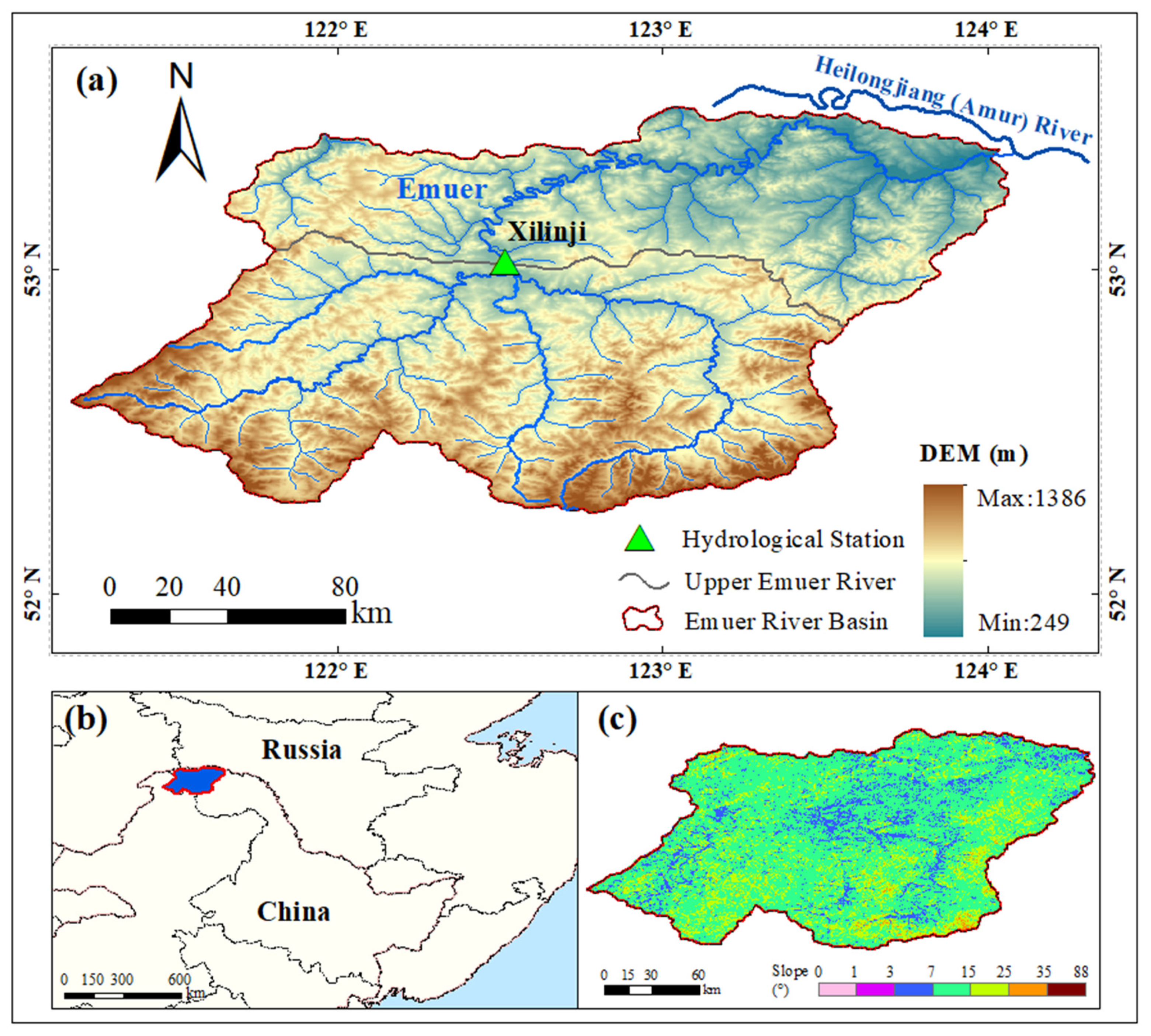
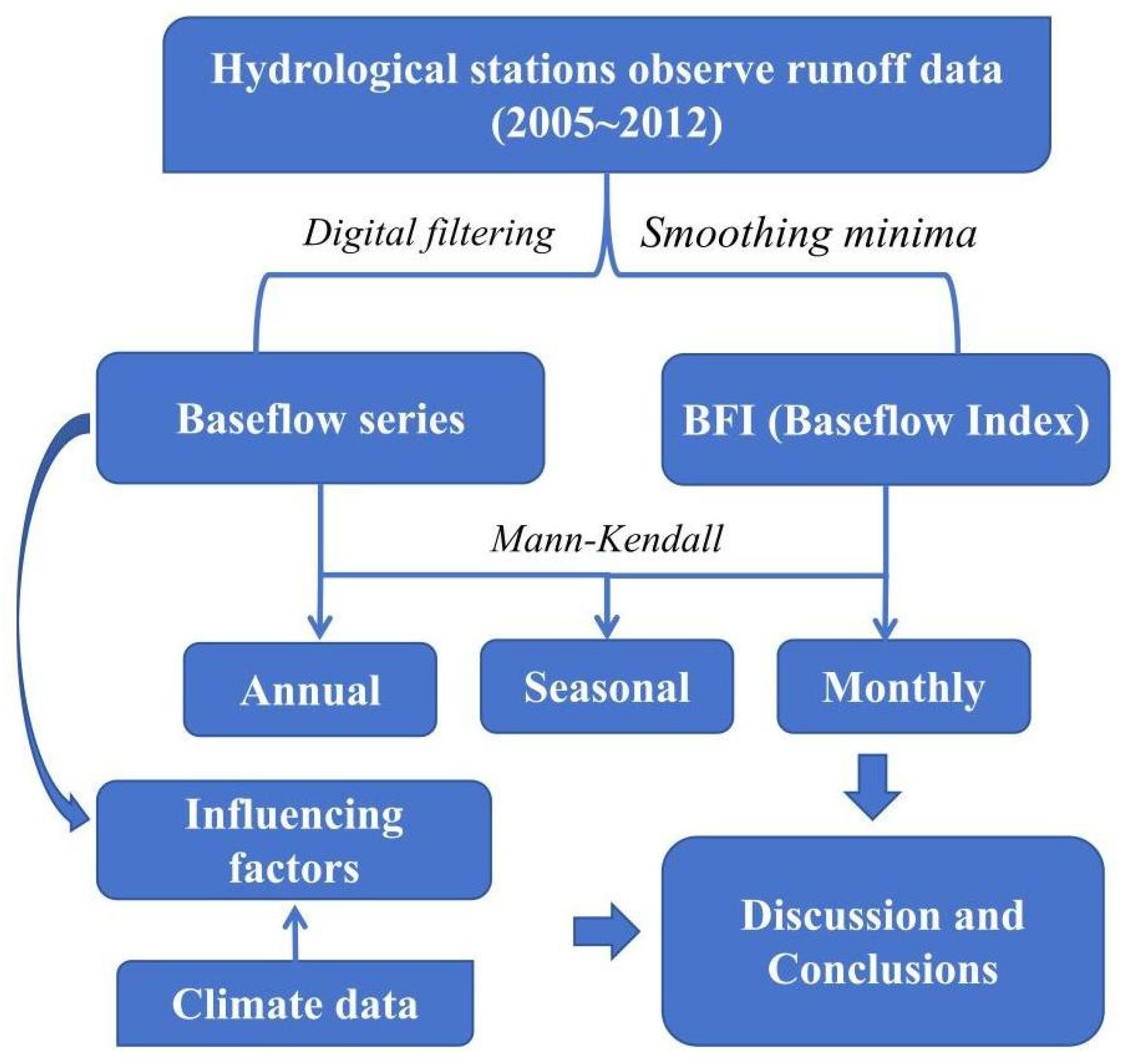
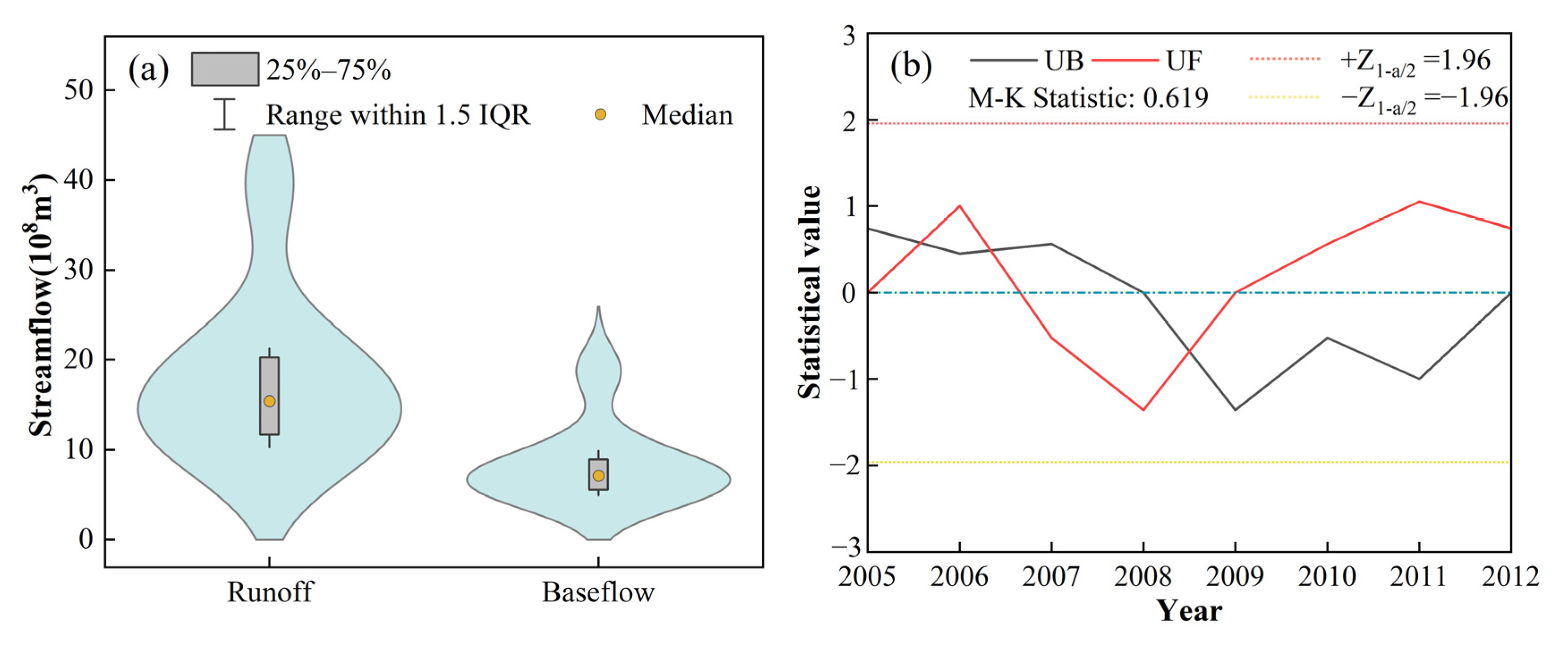

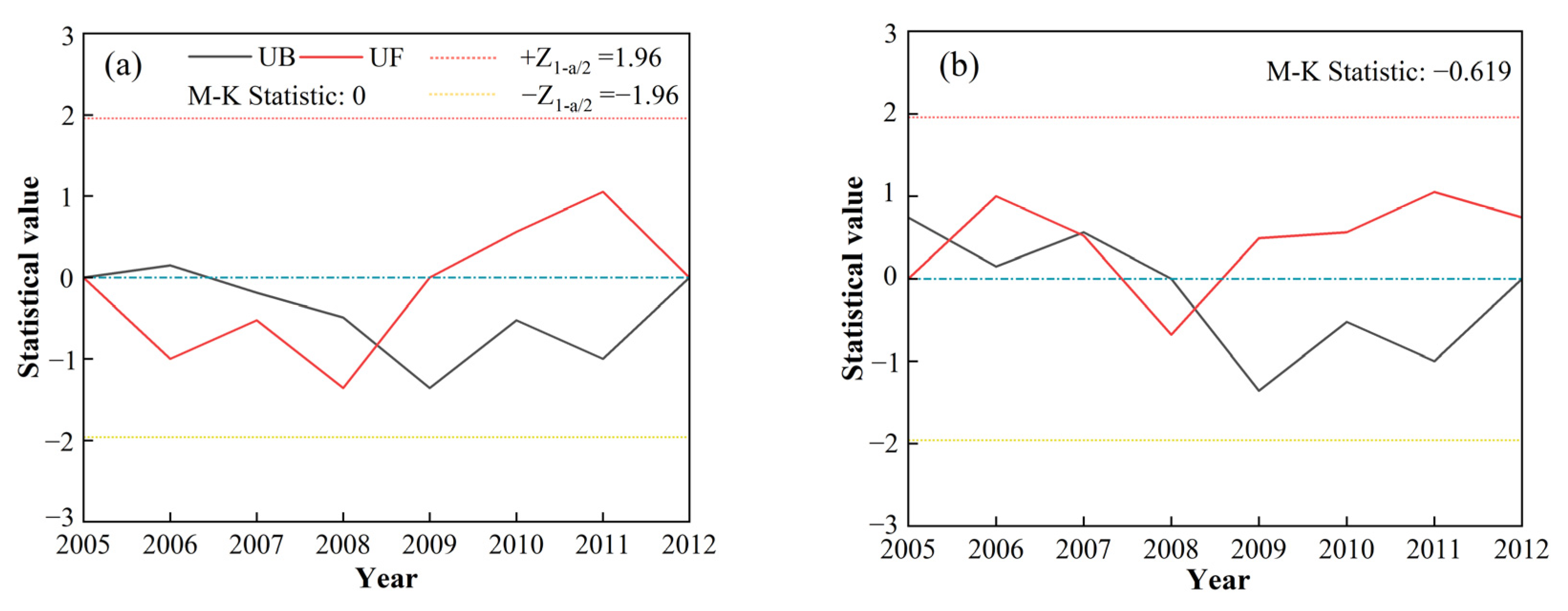
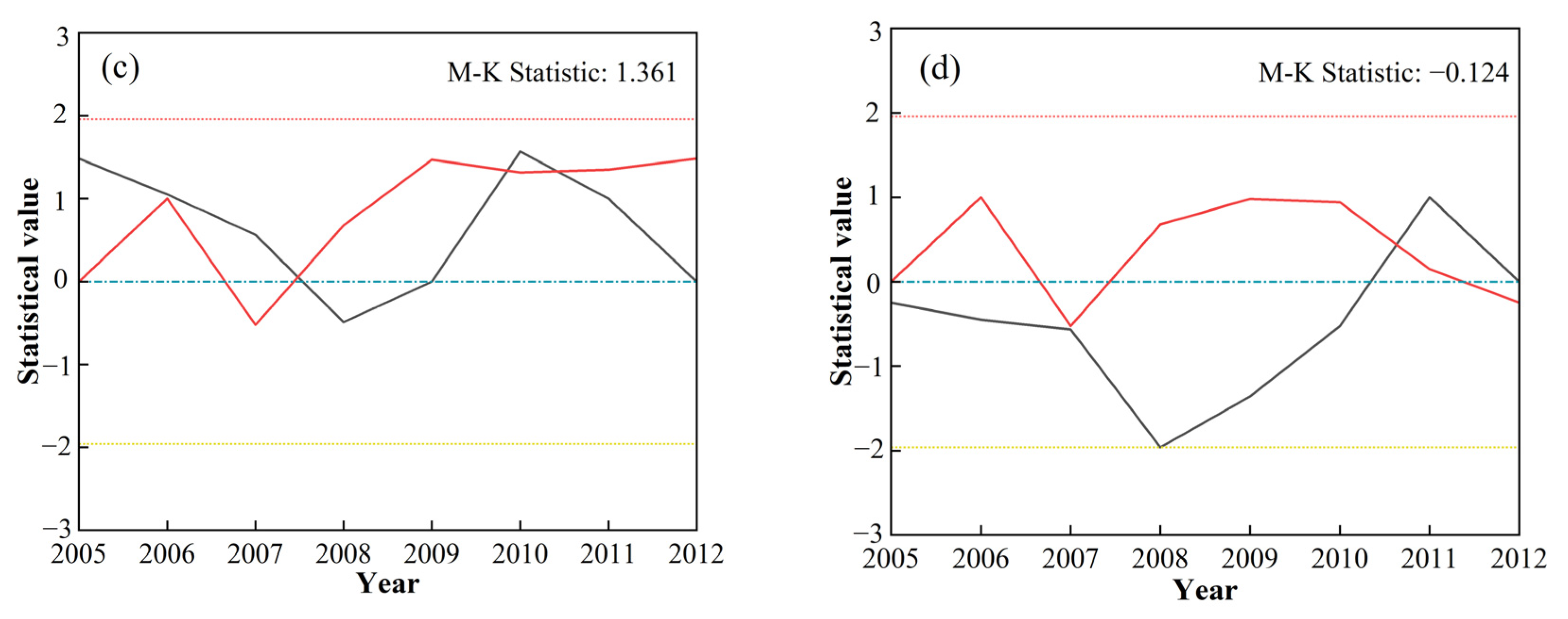
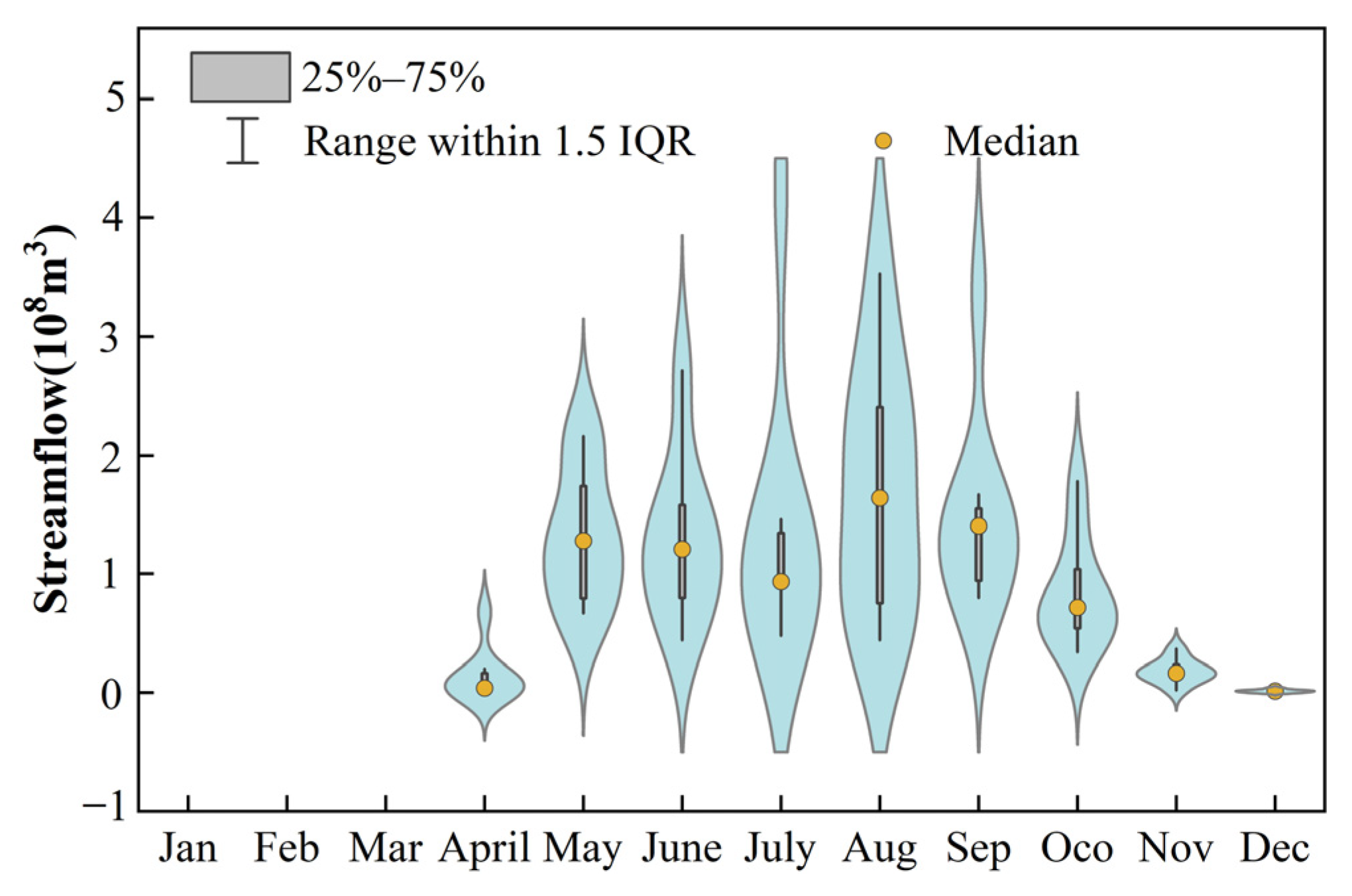
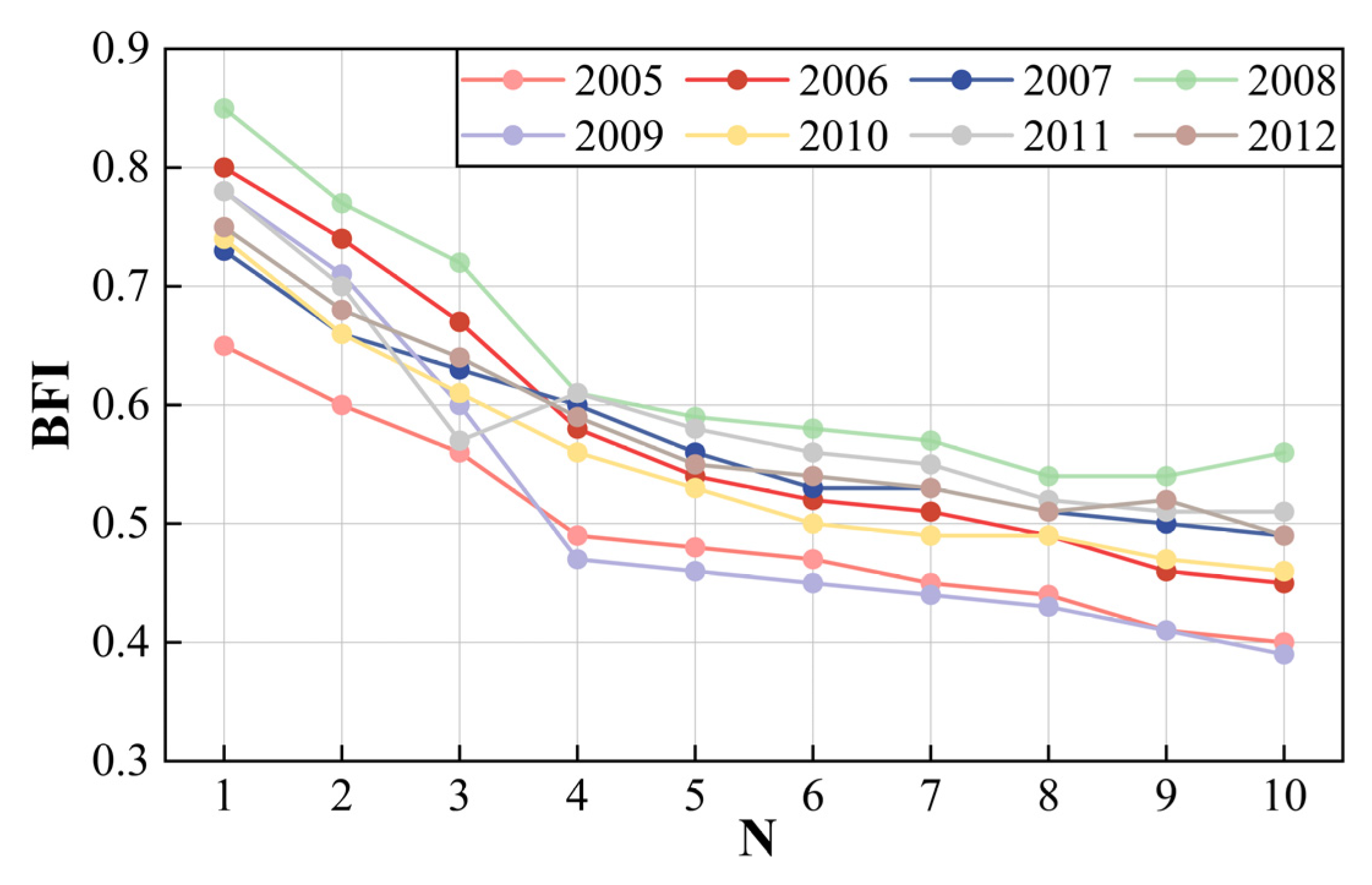
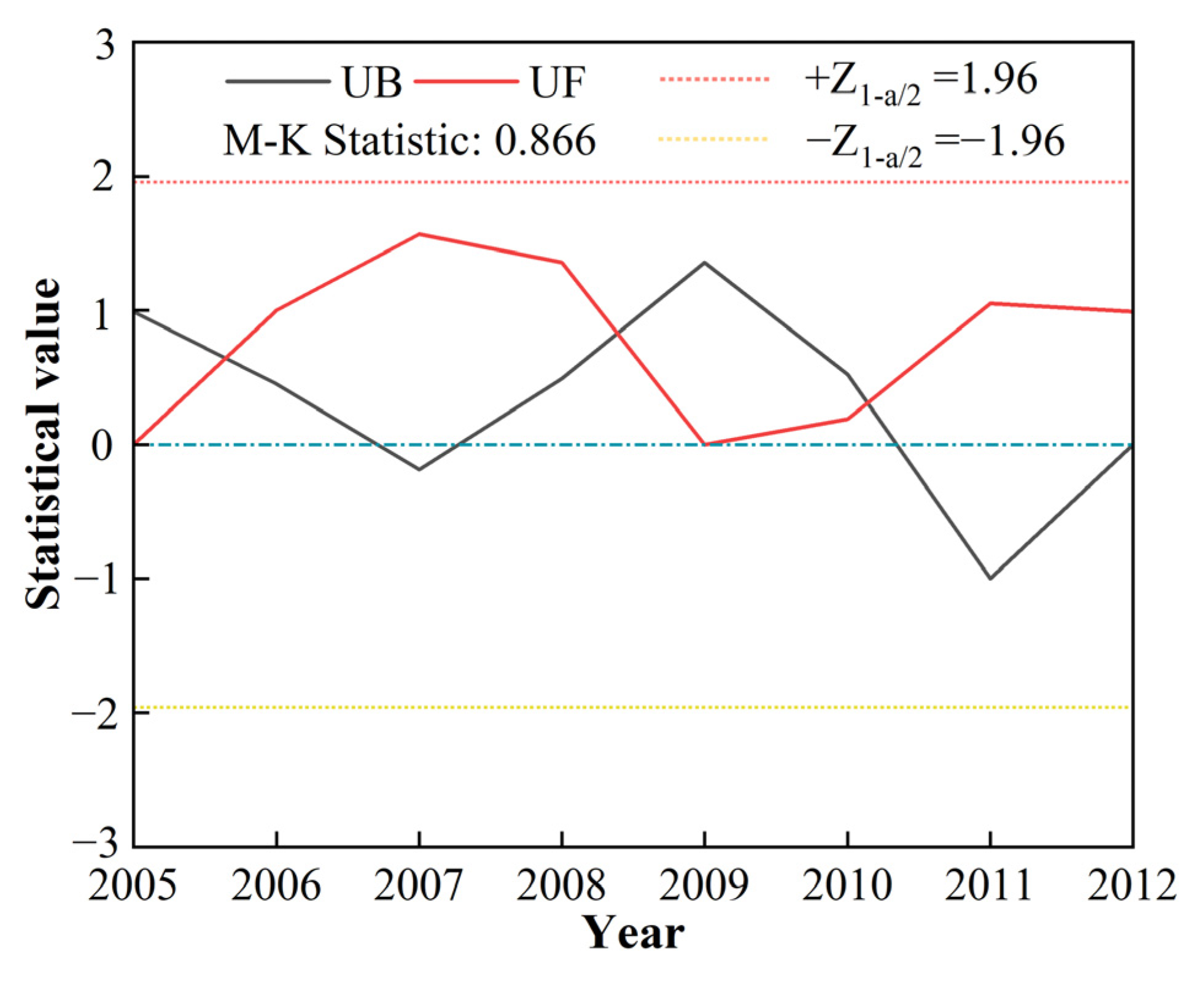
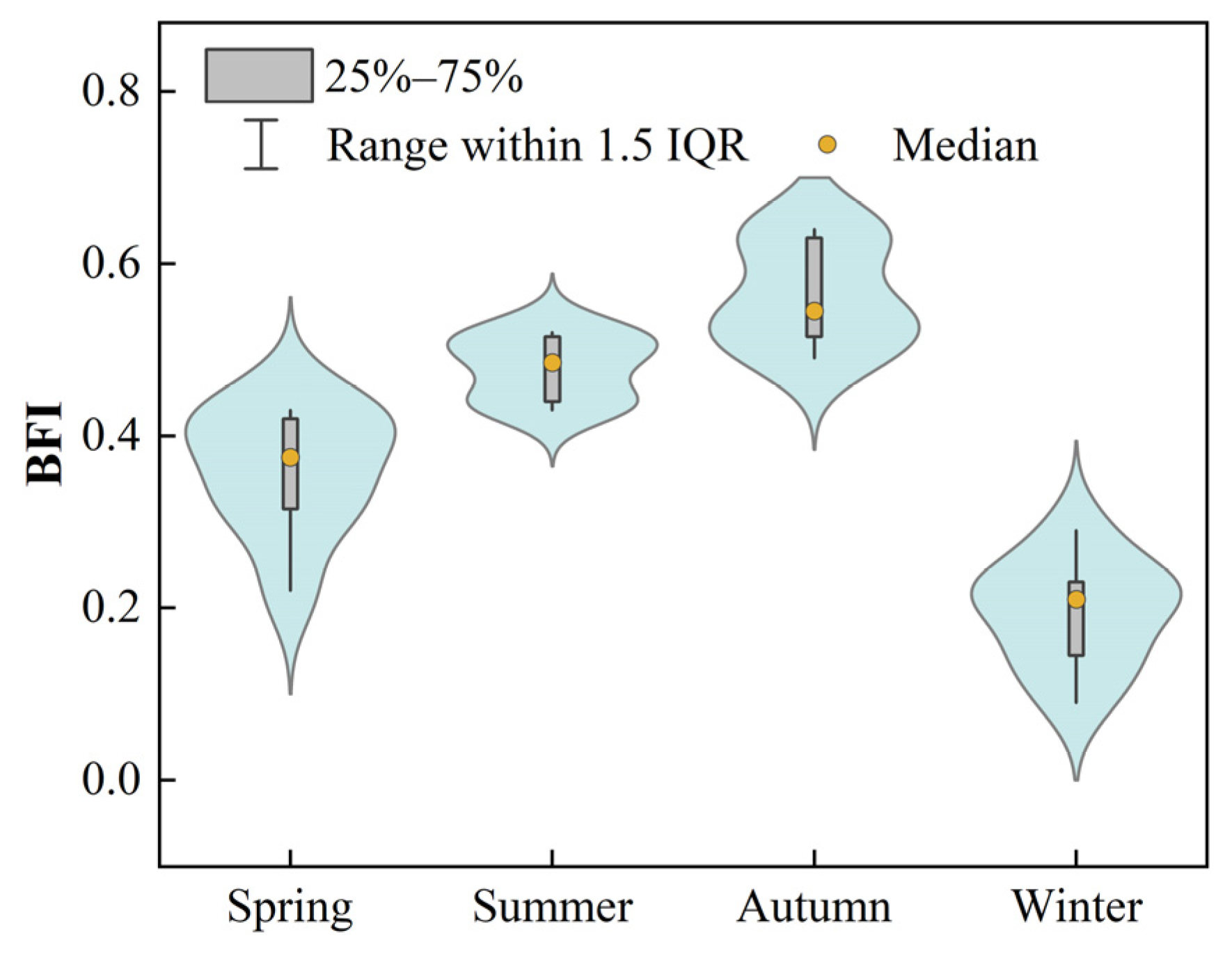
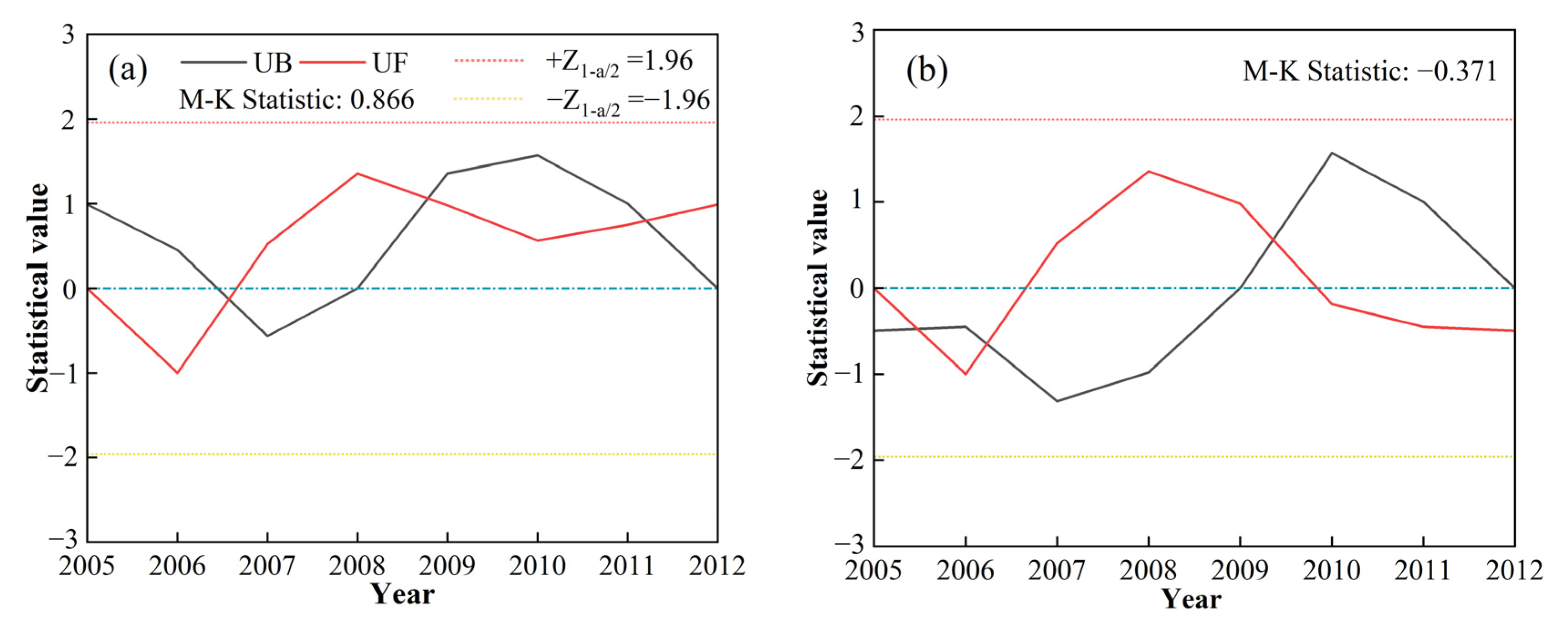



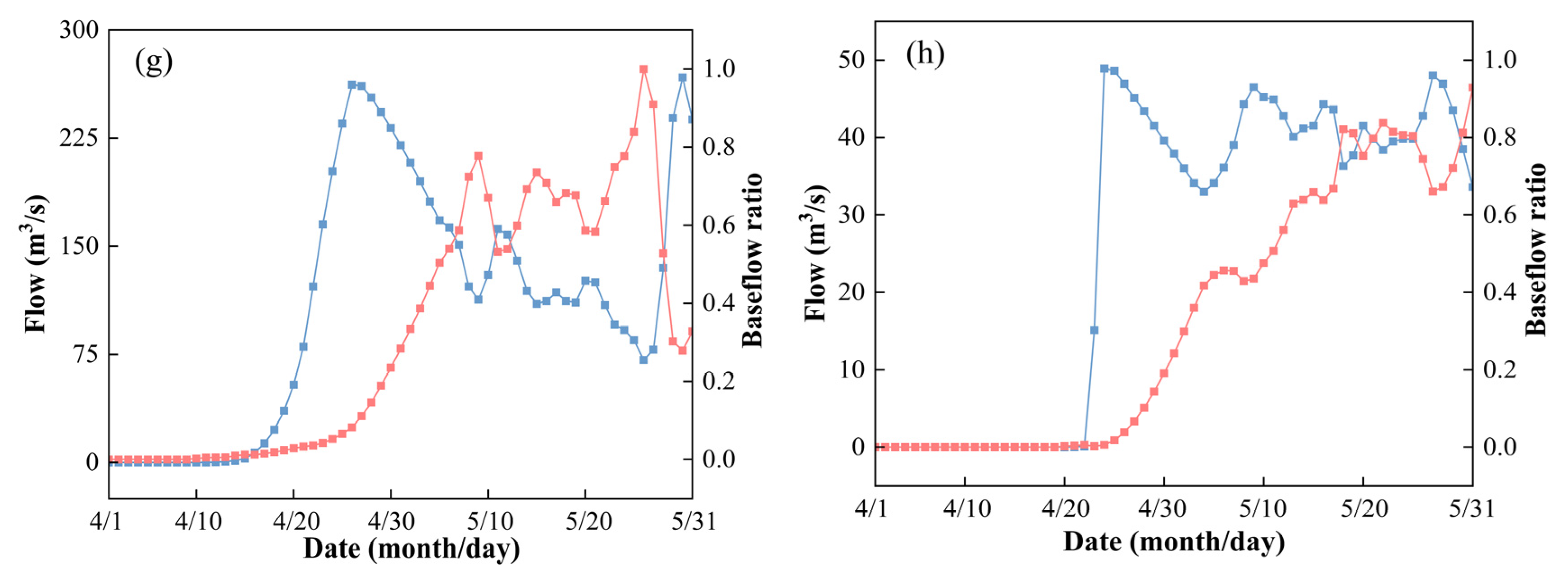
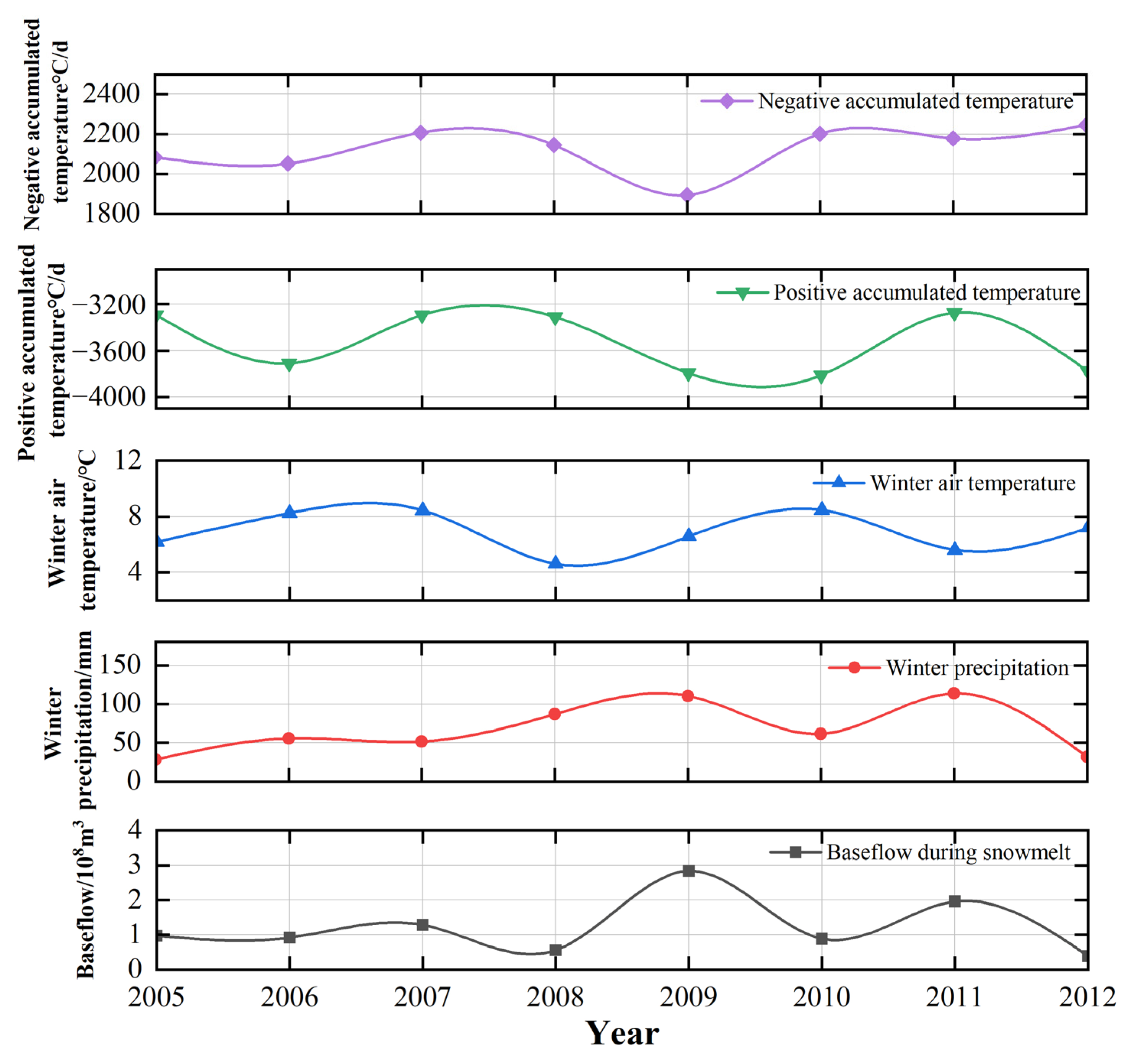
| Month | Trend | Significance Test | |
|---|---|---|---|
| April | 0.86603 | Increase | Non-Significant |
| May | 0.12372 | Increase | Non-Significant |
| June | −0.12372 | Decrease | Non-Significant |
| July | 0.37115 | Increase | Non-Significant |
| August | 0.61859 | Increase | Non-Significant |
| September | 1.6083 | Increase | Significant |
| October | 0.86603 | Increase | Non-Significant |
| November | −0.61859 | Decrease | Non-Significant |
| December | −0.12372 | Decrease | Non-Significant |
| Month | Trend | Significance Test | |
|---|---|---|---|
| April | 0.37115 | Increase | Non-Significant |
| May | 1.1135 | Increase | Non-Significant |
| June | 1.3609 | Increase | Non-Significant |
| July | 0.12372 | Increase | Non-Significant |
| August | −2.3506 | Decrease | Significant |
| September | 1.1135 | Increase | Non-Significant |
| October | 0.37115 | Increase | Non-Significant |
| November | −0.37115 | Decrease | Non-Significant |
| December | −0.86603 | Decrease | Non-Significant |
| Year | Snowmelt Start Date | Snowmelt End Date |
|---|---|---|
| 2005 | 21 April | 25 May |
| 2006 | 23 April | 30 May |
| 2007 | 18 April | 31 May |
| 2008 | 12 April | 20 May |
| 2009 | 6 April | 31 May |
| 2010 | 23 April | 19 May |
| 2011 | 10 April | 26 May |
| 2012 | 20 April | 20 May |
| Climate Factor | Snowmelt Season Baseflow | Climate Factor | Snowmelt Season Baseflow |
|---|---|---|---|
| Winter air Temperature (°C) | −0.105 | Winter Precipitation (mm) | 0.724 * |
| Negative Accumulated Temperature (°C·d) | −0.052 | Positive Accumulated Temperature (°C·d) | −0.676 |
Disclaimer/Publisher’s Note: The statements, opinions and data contained in all publications are solely those of the individual author(s) and contributor(s) and not of MDPI and/or the editor(s). MDPI and/or the editor(s) disclaim responsibility for any injury to people or property resulting from any ideas, methods, instructions or products referred to in the content. |
© 2025 by the authors. Licensee MDPI, Basel, Switzerland. This article is an open access article distributed under the terms and conditions of the Creative Commons Attribution (CC BY) license (https://creativecommons.org/licenses/by/4.0/).
Share and Cite
Jia, M.; Dai, C.; Zhang, K.; Yang, H.; Bao, J.; Shang, Y.; Wu, Y. Study on the Temporal Variability and Influencing Factors of Baseflow in High-Latitude Cold Region Rivers: A Case Study of the Upper Emuer River. Water 2025, 17, 1132. https://doi.org/10.3390/w17081132
Jia M, Dai C, Zhang K, Yang H, Bao J, Shang Y, Wu Y. Study on the Temporal Variability and Influencing Factors of Baseflow in High-Latitude Cold Region Rivers: A Case Study of the Upper Emuer River. Water. 2025; 17(8):1132. https://doi.org/10.3390/w17081132
Chicago/Turabian StyleJia, Minghui, Changlei Dai, Kaiwen Zhang, Hongnan Yang, Juntao Bao, Yunhu Shang, and Yi Wu. 2025. "Study on the Temporal Variability and Influencing Factors of Baseflow in High-Latitude Cold Region Rivers: A Case Study of the Upper Emuer River" Water 17, no. 8: 1132. https://doi.org/10.3390/w17081132
APA StyleJia, M., Dai, C., Zhang, K., Yang, H., Bao, J., Shang, Y., & Wu, Y. (2025). Study on the Temporal Variability and Influencing Factors of Baseflow in High-Latitude Cold Region Rivers: A Case Study of the Upper Emuer River. Water, 17(8), 1132. https://doi.org/10.3390/w17081132






